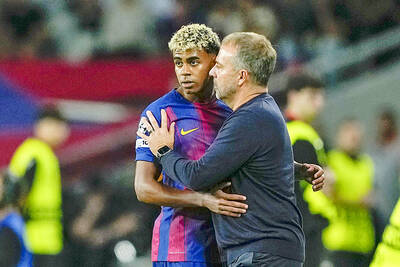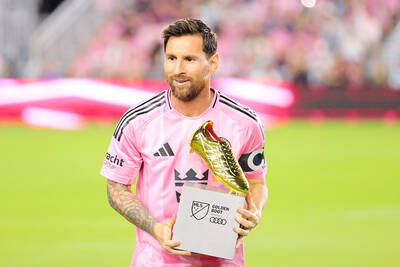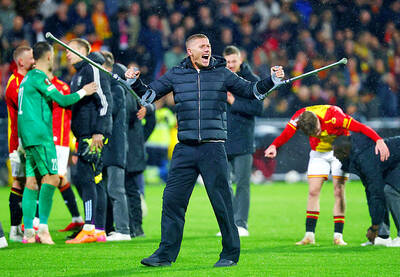Erving McLean reclined on his stoop on West 130th Street near Lenox Avenue, a can of Ballantine Ale in his hand and US$160 in his pocket from a day's work carrying golf clubs at the Blind Brook Club in Rye Brook, New York.
He started caddying at age 12, in North Carolina, and spent many years on the road working for some of golf's biggest names, like Sam Snead and Julius Boros. McLean, now 68, and two of his former colleagues from the pro tour live in Harlem because of its easy access to a wide array of suburban country clubs.
The three caddies, whose decades on golf courses show in their weathered faces, strong hands and good eyes, spend days walking verdant fairways, watching the well-heeled at leisure. Evenings are passed on stoops and streets near the Apollo Theater and Sylvia's soul food restaurant.
"We call this the Harlem caddie shack," McLean said, noting that dozens of other caddies also live in the neighborhood because of its affordability and convenience.
For some, the idea of a caddie may evoke the gang from the 1980 movie Caddyshack, or clean-cut kids collecting pocket change for college. But the mainstay of most caddie shacks is a first-string lineup of veterans like these three, who have worked at little else since childhood. Beyond a strong back, these men offer intimate knowledge of the game and the courses.
The work is seasonal and offers no benefits, job security or pension. An 18-hole round typically lasts three to five hours and pays U$100 to US$200 for carrying a pair of 18kg golf bags, depending on the club -- and the tipper. Payday comes every afternoon on the final green, in cash, which is often spent promptly.
"My best year was 1984 when I won US$84,000 in prize money," McLean said. "But the money always went quick because I never knew how to handle it. I supported five kids and I bought garter belts for plenty of women."
McLean said that he has diabetes and high blood pressure and has had fainting spells.
"Soon as I can start getting a disability check, I'm retiring," he said.
Some caddies migrate south with the birds to work through the winter. McLean and his buddies -- Sam McCray, who still has his white jumpsuit and green cap from his days caddying at Augusta National Golf Club, home of the Masters Tournament, and Clinton Clifton, 73 yet still known as Sonny -- survive locally off savings, odd jobs and public assistance.
They car pool or take the Metro-North train and public buses to Blind Brook and half a dozen other lush courses in Westchester County, on Long Island or in New Jersey, joining thousands of caddies who work at the more than 200 private clubs within a 120km radius of Manhattan. You can find them among the older set lounging at picnic tables as they await a foursome, playing cards or trading stories of their glory days caddying for famous professionals.
McCray, 65, said he was a regular caddie for Tom Weiskopf, a 15-time winner of the Professional Golfers Association tour and the 1973 British Open champion. He said he was there the day Weiskopf scored a 13 on the 12th hole during the 1980 Masters. That matched the highest score ever on a single hole in the vaunted competition.
In a telephone interview on Friday, Weiskopf recalled McCray as an able caddie who had worked for him on and off. He said that McCray was not his caddie that day at the 1980 Masters, but that "he may have been in my group working for another golfer."
Joe Davis, 72, a member of the Winged Foot Golf Club in New York, said he has known Clifton for more than 20 years and that caddies and golfers, while on different rungs of the country club ladder, often form strong friendships as they age.
"Some of these guys are the same age as me, but they can't retire," said Davis, who retired from Wall Street in 2001.
"It's a matter of opportunity," he said, watching McCray, in his Masters jumpsuit, caddying for a foursome. "I was born 6-foot-4 [1.93m] and white, and he was born 6-foot-4 and black. That's the only difference."

Barcelona star Lamine Yamal would be motivated by criticism ahead of the Clasico, Barcelona assistant coach Marcus Sorg said yesterday. Teenage winger Yamal has been in the spotlight in the Spanish capital after joking that Real Madrid “steal” and “complain” during an appearance on a social media stream. Champions Barca face Real Madrid today in La Liga at the Santiago Bernabeu, looking for a fifth consecutive win over their rivals. “Lamine is a top player and I think [the criticism] will be motivating for him,” Sorg told a news conference. “I hope we all see him tomorrow [give] the best performance.” The 18-year-old Spain

‘A HISTORIC moment’: ‘I think we all need to take a step back and appreciate Leo Messi is playing in Major League Soccer,’ league commissioner Don Garber said Lionel Messi raised the Golden Boot. He then got Inter Miami started with his head. The Argentine opened the scoring with a diving header in the first half, then capped the scoring in the 96th minute as Inter Miami opened the MLS playoffs with a 3-1 win over Nashville SC in Game 1 of their Eastern Conference best-of-three first-round series on Friday night. Messi and Ian Fray had the assists on Tadeo Allende’s second-half tally for Inter Miami, who now get two chances to advance out of the first round for the first time in Messi’s two-and-a-half-year tenure with the team. Game

‘COMPLETE GAME’: ‘To be honest, I’m not sure about the history, but I’m very happy about what I did today,’ Yamamoto said through a translator after the game Yoshinobu Yamamoto pitched a World Series game from another era. Sandy Koufax had October outings like this, and so did Orel Hershiser, but those types of performances have vanished in modern baseball. Until this 178cm starter from Japan delivered like the aces of old. Yamamoto threw a four-hitter for his second consecutive complete game, the first in the World Series since 2015, and the defending champion Los Angeles Dodgers beat the Toronto Blue Jays 5-1 on Saturday night to tie their best-of-seven matchup at one game apiece. “It’s kind of the throwback,” Dodgers manager Dave Roberts said. “When he starts a game, he

Sean Dyche on Thursday achieved in his first game with Nottingham Forest what predecessor Ange Postecoglou could not in eight matches in charge: Win. Under its new coach, Nottingham Forest presented a concentrated display resulting in a 2-0 victory over Porto in the UEFA Europa League. It was the first victory for Nottingham in the competition and only the second overall this season, while Porto were defeated for the first time this season. Morgan Gibbs-White converted from the penalty spot in the 19th minute at the City Ground in West Bridgford, England. Igor Jesus doubled the advantage from another penalty in the 77th